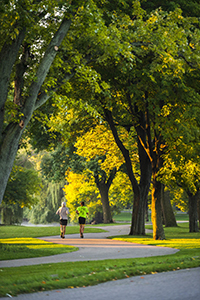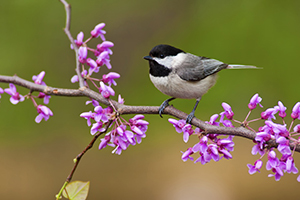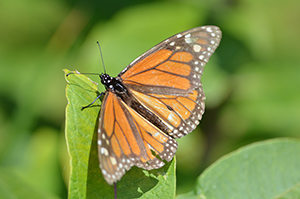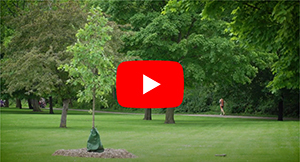|
Earth Day is April 22, and Arbor Day is April 24. While in-person gatherings to mark these annual celebrations and other volunteer stewardship events have been canceled to help slow the spread of COVID-19, there are ways you can support conservation and get involved in taking care of Michigan’s natural resources from home.
Be sure to maintain social distancing while outside by staying 6 feet away from anyone not in your household. Follow our DNR COVID-19 response page for FAQs and updates on facilities and closures/cancellations, and stay up to date on the latest public health guidelines and news at Michigan.gov/Coronavirus and CDC.gov/Coronavirus.

In-person Earth Day events may be canceled, but we still can get into the spirit of the annual environmental observance – marking its 50th anniversary this year – by taking action and celebrating at home.
Consider the following suggestions for how you and your family can contribute to a healthier and cleaner planet:
- Take a family walk and observe nature.
- Plant some trees or native wildflower seeds or put in a rain or butterfly garden. See the stories below for more information on tree planting and gardening for pollinators.
- Ride a bike or take a hike.
See 11 actions for the planet during a pandemic for more ideas, or find a digital Earth Day event.
And check out Five Days of Earth Day, a series of short videos from the DNR’s education team that highlight many aspects of what it means to enjoy, share and take care of the world around us. A new video drops every morning this week at 9 a.m. on Facebook at @MiNatureDNR.
The photo above shows one of the winners of the 2020 Earth Day Poster Contest, created by first grader Juliana Gjokaj of Monfort Elementary in Shelby Township. See all poster contest winners.
|

Michigan’s 20 million acres of forests and abundant urban trees do a lot for us: trees clean our air and water, make homes for wildlife, create forests for us to hike and bike through, absorb carbon, keep us cool, supply renewable materials for the things we need and provide natural beauty.
Arbor Day, celebrated the last Friday in April, is a holiday dedicated to all the great things trees do for us. It’s especially important for Michigan. Did you know Arbor Day, first held in 1872, was championed by Michigan native J. Sterling Morton? He envisioned it as a way to spread awareness about the importance of trees and encourage tree planting.
We can keep that vision thriving by finding ways to celebrate Arbor Day locally as we observe social distancing guidelines. Here are some fun ideas:
Visit the Arbor Day Foundation website for more ways to observe Arbor Day while social distancing this year.
Find more information about Arbor Day on the Michigan Arbor Day Alliance website or the DNR’s Urban and Community Forestry webpage.
|

Jump-start a connection to nature this Arbor Day by planning to plant a native tree. While some nurseries are closed due to COVID-19 mitigation, you can plan now for the trees you want to plant when nurseries reopen. Check out online tree-buying options like the Arbor Day Foundation or check with your local conservation district – many have arranged opportunities to buy trees while maintaining proper distance from others.
Trees native to Michigan are easy to care for and provide many benefits to wildlife, including food and shelter, as well as the environment. Learn more about the benefits of trees.
While landscape trees from other parts of the world may be pretty, they don’t provide as many ecological benefits (like wildlife food) as native trees. Picks for native trees that wildlife will flock to include eastern redbud, American elderberry, white oak, serviceberry (juneberry) and mountain ash.
Learn more on our webpage about native trees to plant to attract backyard wildlife. You can get native plant recommendations based on zip code from the Audubon Society.
Spring and fall are the best times of the year to plant trees. See tree planting guidelines at ArborDay.org.
|

Arbor Day is the perfect time start thinking about the benefits and natural beauty of trees and plants. Before you grab a shovel, make sure to pick the perfect spot for a tree to grow.
Creating a sun map to track sun exposure in your growing space can help. You can make a sun map for a backyard, a garden plot or even a porch or balcony.
To create a sun map, make a diagram of your yard and divide it into quadrants. It may help to visually mark the lines in your yard with string, a garden hose or chalk. Each hour after sunrise, make a tally mark on each area of your diagram that receives full sun. At the end of the day, add up the marks to determine the hours of sun exposure each area gets.
Once you know your sun situation, it’s easy to pick the appropriate trees and plants for your growing space.
Plants and trees labeled “full sun” need six or more hours of sunlight per day. “Part-sun” or “part-shade” labels indicate that the plant needs three to six hours of sunlight, and those labeled “shade” require three hours or less of sunlight each day. In addition to sun exposure, moisture, wind and soil conditions also will affect the success of trees and plants.
|

Monarch butterflies, bees and other insects – despite their small size – play a very large role in humans’ lives as they travel to flowering plants, drinking nectar and transporting pollen. Pollinators like butterflies and bees are responsible for approximately one-third of the world’s food source.
Due to a loss of habitat, the eastern monarch butterfly population has declined by 90% over the last 20 years, and bees have declined 50% in recent decades. These alarming drops have sparked conservation programs across the nation to take action, and thanks to efforts to protect pollinators and restore habitat, monarch populations have increased steadily over the last few years.
There are a variety of ways you can help monarchs and other important pollinators in Michigan, including becoming aware of and participating in ongoing conservation efforts.
Some ideas for how you can get involved:
|

The tallies are in, and the DNR and Arbor Day Foundation are announcing that 122 Michigan communities, eight campuses, one healthcare institution and one utility have received “Tree City USA” awards, including those enrolled in associated Tree Campus, Tree Campus Healthcare and Tree Line programs.
Tree USA programs promote care and management of community trees and call attention to the benefits they provide. Not familiar with the program? Watch our Tree City video to learn more.
Our state comes in eighth nationally in number of certified communiites, as this year the cities of Ferrysburg and Wyandotte joined the ranks of Michigan's Tree Cities. See which other Michigan cities earned Tree City USA status.
Additionally, Spectrum Healthcare's Blodgett Hospital in Grand Rapids is one of the first institutions in the country to achieve Tree Campus Healthcare status.
“Tree City USA helps communities set goals, raise awareness and reinforce the importance of trees,” said DNR Urban Forestry coordinator Kevin Sayers.
To be recognized as a Tree City, a community must meet four standards: maintaining a tree board or department, having a community tree ordinance, spending at least $2 per capita on urban forestry and celebrating Arbor Day. Learn more about the programs at ArborDay.org/Programs.
Contact Kevin Sayers, 517-284-5898, or visit Michigan.gov/UCF for more about the DNR's Urban and Community Forestry program.
|
|
|
As you’re enjoying Michigan’s outdoors – while staying close to home – you can help prevent the spread of invasive species that threaten our land and water resources by reporting invasive species sightings. Early detection and timely reporting of these species are crucial for decreasing the chances of them taking hold, which is key to limiting potential ecological, social and economic effects.
|
|
Federal money provided for many important activities – from wildlife restoration, hunter education and wildland fire preparation to disaster relief, water pollution control and so many others – is distributed to states based on census results. Take 10 minutes to complete the 2020 census, if you haven’t already, and help ensure Michigan gets its fair share of federal funding for vital programs and projects for the next 10 years.
|
|
|